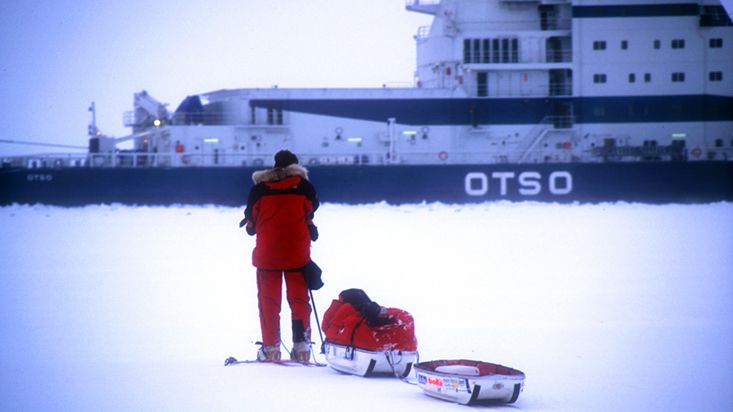Top Arctic World Expeditions
Recommended video
Outstanding News
Travel Map
IPGA Association
Specialists in Iceland






A few years later of the Discovery of America, the explorers wanted to find a shorter sea route to go from Europe to Asia, because the two routes that existed in the early XV century, were extremely long routes: the Cape of Good Hope in Africa and the feared Cape Horn, in the south of the American continent.
It was at the end of that century, when the explorer realized that the shortest route to reach Asia from Europe route was sailing through the Northwest Passage, crossing the Atlantic and the Pacific through the unexplored Arctic, which is now known as Canada.
For centuries, many of the great explorers and sailors tried unsuccessfully to find the way to pass through the maze of islands and frozen lands, but the extreme hardness of the Arctic and the permanently frozen sea, even in summer, defeated again and again those brave seamen.
In 1845, several centuries after the first attempts to find the Northwest Passage, the officer of the British Navy, Sir John Franklin was chosen to command the most powerful and the best Arctic expedition of the polar history, up until that moment. Their main objective was to navigate and to map the complete route.
The expedition was to consist of two ships, HMS Erebus and HMS Terror, each of which had seen Antarctic, 129 sailmen and three years' worth of conventionally preserved or tinned preserved food supplies. All the crew, including the captain, died in the unforgiving Arctic and both vessels disappeared without a trace.
After several years without news of the seafarers, in 1848 Jane Franklin, Franklin’s wife, together with the victim’s families, lobbied the British government to initiate the search and rescue effort of the Arctic expedition.
In one of the first rescue expeditions, in southern part of Devon Island (one of the key steps of the Northwest Passage), there were found clues and signs of the Franklin’s expeditions, as well as the graves where they were buried two sailors.
In 1854, during the expedition command by John Rae, discovered further evidence of the lost men's fate. Rae met an Inuk, who told him of a party of 35 to 40 white men who had died of starvation near the mouth of the Back River. Other Inuit confirmed this story, which included reports of cannibalism among the dying sailors.
Rae's report was sent to the Admiralty, which in October 1854 urged the HBC to send an expedition down the Back River to search for other signs of Franklin and his men.
Despite the findings of Rae and Anderson, the Admiralty did not plan another search of its own. Britain officially labelled the crew deceased in service on 31 March 1854.
Lady Franklin, failing to convince the government to fund another search, personally commissioned one more expedition under Francis Leopold McClintock on King William Island. Finally in 1859 received funding to start what would be the last expedition in search of Franklin. On May, they found a document dated 25 April 1848 that said "Sir John Franklin commanding the Expedition. All well “.The second message, written in the margins of that same sheet of paper, was much more ominous. It reported that Erebus and Terror had been trapped in the ice for a year and a half and that the crew had abandoned the ships on 22 April. Twenty-four officers and crew had died, including Franklin on 11 June 1847.
Despite to reach some bodies and numerous objects of the crew, the mystery of what exactly happened were unresolved and boats were still missing.
One of the most important consequences of the failed Franklin expedition, was that thanks to the successive search expeditions were mapped thousands of miles of Arctic coast that had not been explored at that time.
After the expedition of Mc Clintock, for nearly a century, the search of Franklin fade away until the XXth century, where a group of scientists undertake a scientific study of the graves, bodies and materials of the crew found in Beechey island and King Williams.
The analysis of these studies conducted in 1981, concluded that the main causes of death were diseases of the crew as pneumonia, scuvy and tuberculosis, lead poisoning from lead of the cans and drinking water contaminated of the ships.
The mystery was buried in the frozen Arctic, until last September 7, 2014. A Canadian research team using a remote underwater vehicle found in the vicinity of the island of King Williams, the Erebus, one of the two vessels of the Franklin expedition.
Stephen Harper, Prime Minister of Canada said: “Finding the first vessel will no doubt provide the momentum — or wind in our sails — necessary to locate its sister ship and find out even more about what happened to the Franklin expedition’s crew”.
There are still many questions that have no answers. One of these questions is whether Franklin's body could be found among the wreckage? Because we still do not know if Franklin died on board or his body was thrown into the sea before all the sailmen left the ship.
There are still many questions to be resolved, but thanks to the discovery of the Erebus, is solved part of the mystery of almost 170 years. This fact is for the Arctic polar historians like the discovery of the legendary tomb of Tutankhamon by the British archaeologist Howard Carter in 1922, in Egypt.
* Note: HMS stands mean Her Majesty Ship.
Image Credits:
- Franklin’s boat - National Maritime Museum, Greenwich.
- Sir John Franklin - National Portrait Gallery, London.
- Lady Jane Franklin - National Portrait Gallery, London.
- HMS Erebus in the ice - National Maritime Museum, Greenwich.
- HMS Erebus passing-through the chain of bergs - National Maritime Museum, Greenwich.
- HMS Terror - National Maritime Museum, Greenwich.





























